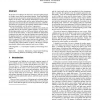Free Online Productivity Tools
i2Speak
i2Symbol
i2OCR
iTex2Img
iWeb2Print
iWeb2Shot
i2Type
iPdf2Split
iPdf2Merge
i2Bopomofo
i2Arabic
i2Style
i2Image
i2PDF
iLatex2Rtf
Sci2ools
SIGGRAPH
2000
ACM
2000
ACM
A fast relighting engine for interactive cinematic lighting design
We present new techniques for interactive cinematic lighting design of complex scenes that use procedural shaders. Deep-framebuffers are used to store the geometric and optical information of the visible surfaces of an image. The geometric information is represented as collections of oriented points, and the optical information is represented as bi-directional reflection distribution functions, or BRDFs. The BRDFs are generated by procedurally defined surface texturing functions that spatially vary the surfaces’ appearances. The deep-framebuffer information is rendered using a multi-pass algorithm built on the OpenGL graphics pipeline. In order to handle both physically-correct as well as non-realistic reflection models used in the film industry, we factor the BRDF into independent components that map onto both the lighting and texturing units of the graphics hardware. A similar factorization is used to control the lighting distribution. Using these techniques, lighting calculat...
Computer Graphics | Interactive Cinematic Lighting | Lighting | SIGGRAPH 2000 | Surface Texturing Functions |
| Added | 01 Aug 2010 |
| Updated | 01 Aug 2010 |
| Type | Conference |
| Year | 2000 |
| Where | SIGGRAPH |
| Authors | Reid Gershbein, Pat Hanrahan |
Comments (0)

